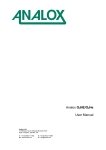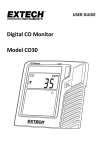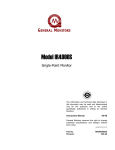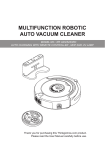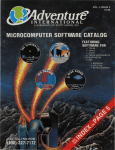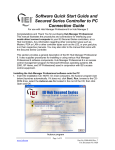Download Minimax-XT User Manual
Transcript
PERSONAL GAS MONITOR U S E R A N D M A I N T E N A N C E M A N U A L 1. INTRODUCTION The MiniMAX XT is a disposable, easy to use, personal gas monitor, designed for 2 years continuous monitoring of the atmosphere for potentially hazardous levels of Oxygen deficiency or toxic gas. SAFETY INFORMATION • Substitution of components may impair intrinsic safety • Do not activate the detector after the date on the packaging • Perform a self-test prior to each day’s use • Do not use in oxygen-enriched atmospheres • Before each day's use test the MiniMAX XT with a known concentration of gas that is above the alarm levels of the instrument, and ensure the instrument produces an alarm. IMPORTANT NOTICE Lumidor can take no responsibility for use of its equipment if this is not done in accordance with the appropriate issue and/or amendment of the relevant manual. If further details are required which do not appear in this manual, contact Lumidor or their agent. Lumidor shall not be liable for any incidental or consequential damages in connection with any deletions, errors or omissions in this Manual. 2 2. ACTIVATING THE DETECTOR Press the test button as shown below. The detector will emit 5 beeps and 5 flashes. MiniMAX XT will warm up for one minute, showing a countdown in seconds and the Test Pass icon ( ) will be flashing. It will then set the remaining-life clock and perform a self-test. If the detector passes the Test Pass icon ( ) is displayed. If the Test Fail icon ( ) is displayed then the detector has failed the self-test – please refer to the instructions in Section 8. Visual alarm Display Gas Type Audible Alarm Test Button 3 3. DISPLAY FEATURES C D E A F B G E Level 2 alarm: O2 F Lifetime: Months , days , hours G Concentration units J I H H Low peak (O2) A Battery I High peak (CO, H2S) B Test Fail icon J Readout C Test Pass icon D Level 1 alarm: CO, H2S, O2 Level 2 alarm: CO, H2S 4. REMAINING LIFETIME CLOCK The remaining lifetime clock indicates how much longer the detector will operate. This is shown on the display as a countdown of remaining months (indicated by the icon), then days ( ) and finally hours ( ). The example to the right shows 24 months remaining. 4 5. GAS ALARMS The MiniMAX XT has two levels of gas alarm, of which the level 2 alarm is more urgent than the level 1 alarm. The alarm setpoints are: Gas Type H2S CO O2 Level 1 Alarm 10 ppm 35 ppm 23.5%v/v Alarm Level Level 1 alarm Display Level 2 alarm blink blink Level 2 Alarm 15 ppm 100 ppm 19.5%v/v Audible Alarm 3 beeps per second Visual Alarm 3 flashes per second 5 beeps per second 5 flashes per second Note: When the detected gas levels returns to a safe level the gas alarm will stop. The user cannot cancel an alarm. For units fitted with a vibrating alarm, the unit will vibrate for level 1 and level 2 alarms. 5 6. GAS CONCENTRATION DISPLAY Should the MiniMAX XT unit be exposed to a level of gas in excess of the alarm setpoints the unit will display the concentration of the gas. If the measured reading exceeds the range of the instrument then the numerical digits will flash. 7. MAXIMUM GAS READING The MiniMAX XT records the maximum readings measured under an alarm condition, and records the number of hours since this occurred. As each new higher level of gas is detected this counter is reset to zero, and after 24 hours has elapsed the counter is also reset to zero hours. The maximum gas readings (minimum for Oxygen) can be viewed by pressing the Test button within 24 hours of the gas alarm. This will cause the instrument to perform a self-test (see Section 8), after which the alarm setpoints and the maximum readings will be displayed. For instance, a) the level 1 and level 2 alarm setpoints Level 1 CO Level 2 CO Level 1 O2 Level 2 O2 b) the maximum reading measured Level 1 CO Level 2 CO 6 c) the time elapsed since the maximum reading occurred in hours (e.g. 4 hours) 4 hours 8. PERFORMING A SELF-TEST When the Test button is pressed the unit checks the sensor, circuit, batteries, and audible and visual alarms and vibrating alarm (where fitted). After 24 hours has elapsed since the self-test was last performed the Test Pass icon ( ) will be blinking. The self-test must then be performed, by pressing the Test button. The detector will do the following: • Turn on all the display elements • Tests the audible and visual alarms (and vibrating alarm if fitted) • Check the battery, electronic circuit and sensor • Perform a sensor test • Display the level 1 and level 2 alarm setpoints • Display the maximum (minimum for O2) gas reading (if such a reading has occurred) • Display the time elapsed since this reading in hours (within last 24 hours), if such a reading has occurred 7 • The result of the self-test as follows: Self-Test Result Pass Display Fail Audible Alarm None Visual Alarm None 1 long beep 1 flash If the self-test fails repeat the self-test. The MiniMAX XT will warm up for one minute before the next self-test is performed. If it fails three consecutive times then the detector will display an error code (see Section 11). Additionally, the MiniMAX XT will periodically check its battery, electronic circuit and sensor. If it fails the Test Fail icon ( ) will be shown and the Test Pass icon ( ) will blink. If it passes then the Test Pass icon will be displayed. 9. END OF LIFE ALARM When the MiniMAX XT has less than 1 day of remaining life it will flash the digits, as below: End of Life Warning End of Life Reached When the MiniMAX XT’s life has ended the display will blink as shown above, the audible will beep once every 15 seconds, and the visual will flash once every 15 seconds, (and if fitted the vibrator will operate once every 15 seconds) until the Test button is pressed. The audible will then be turned off, and the detector will shutdown, displaying the relevant error code (see Section 11). 8 10. SAFETY SHUTDOWN In the event that the battery runs out before the end of life is reached (due to excessive alarms) the battery icon will blink, the audible alarm will beep once every 15 seconds, and the visual alarm will flash once every 15 seconds, until the Test button is pressed. The audible will then be turned off, and the detector will shutdown. A shutdown condition can also occur due to failure of the electronic circuitry or sensor. The relevant error code is shown (Section 11). 11. ERROR CODES Sensor Output Range Error Error Code E 01 E 02 E 04 E 08 E16 Reason Sensor Output Range error Battery has run out End of Life reached System Fault EEPROM Error 12. ZERO CALIBRATION (OXYGEN SPAN) This must be performed in a clean atmosphere, and it is recommended that it be performed daily or after any gas alarm. Depress the Test button for 5 seconds. The instrument will initiate a zero by showing a countdown showing a ‘0’ for zero calibration, followed by a countdown from ‘20’ to ‘00’. 9 When the zero calibration has been completed the MiniMAX XT will indicate a pass by beeping twice and flashing 3 times, and the ( ) symbol will flash for 5 seconds. blink If the zero calibration is not OK then the MiniMAX XT will give a single beep and a single flash, the Test Fail icon ( ) will be displayed, and the zero calibration should be repeated. 13. OPTIONAL SPAN CALIBRATION (CO AND H2S VERSIONS ONLY) While the MiniMAX XT requires no calibration for its lifetime of 24 months there may be an occasion when it is deemed necessary to carry out a calibration, for instance, if a self-test fails. To carry out the span calibration the user requires the following additional equipment to be available, which can be purchased from Lumidor. • Gas cylinder containing a known concentration calibration gas as follows: Toxic Gas H2S Calibration concentration 25ppm in air CO 100ppm in air 10 • A gas regulator supplying the gas at 300ml/min flow rate • Tubing for use between the regulator and the test adaptor (supplied) Carry out the zero calibration procedure as described in Section 12. Only if the zero calibration is successful can a span calibration be performed. At the end of the zero calibration procedure, the test button must be pressed continuously for 5 seconds while the ( ) symbol is still flashing. Connect the gas cylinder and test adaptor and apply the gas at 300ml/min. The instrument will display a ‘C’ (for calibration), and count down from ‘60’ to ’00’. If the span calibration is successful the unit will give 2 beeps, 3 flashes and displays the Test Pass icon ( ). If it fails the instrument gives a long beep, long flash and displays the Fail icon ( ) (the calibration remains as it was before the span calibration was attempted). Span calibration - pass Span calibration – fail 11 14. WARRANTY All products are designed and manufactured to the latest internationally recognized standards by Lumidor under a Quality Management system that is certified to ISO 9001. As such Lumidor warrants its products against defective parts and workmanship and will repair or (at its option) replace any instruments which are or may become defective under proper use within 24 months from date of activation provided this takes place prior to the Activate Before date. Defective goods must be returned to Lumidor premises accompanied by a detailed report. Lumidor shall not be liable for any loss or damage whatsoever or howsoever occasioned which may be a direct or indirect result of the use or operation of the Contract Goods by the Buyer or any Party. This warranty covers instrument and parts sold to the Buyer only by authorised distributors, dealers and representatives as appointed by Lumidor. This warranty supercedes all existing warranty statements and Lumidor makes no other warranty expressed or implied except as stated above. The warranties set out in this clause are not pro rata, i.e. the initial warranty period is not extended by virtue of any works carried out there under. For full statement of warranty terms please contact Lumidor. 12 15. SPECIFICATIONS Maximum Operating Life 2 years after activation, assuming 3 minutes of alarm per day Sensor Range CO H2S O2 0 to 1000 ppm (display: 0-200ppm) 0 to 100 ppm (display: 0-100ppm 0 to 30%v/v (display: 0-25%v/v) Alarm Setpoints CO H2S O2 Level 1 35 ppm 10 ppm 23.5% Calibration CO/H2S O2 Zero adjustment (optional Span) Span adjustment Shelf Life 12 months: CO/H2S 6 months: O2 -20°C to +50°C 5-95% RH (non-condensing) 95db @ 10cm High intensity Red LEDs Optional (adds 1.5g to weight of unit) Custom LCD Electrochemical 3.6V non-replaceable Lithium battery IP54 Operating Temperature Humidity Audible Alarm Visual Alarm Vibrating alarm Display Sensor Type Battery IP Rating Level 2 100 ppm 15 ppm 19.5% 13 15. SPECIFICATIONS CONTINUED Intrinsic Safety Europe: EEX ia IIC T4 (ATEX) UL/cUL: Class 1 Div 1 Groups A, B, C, D T4 RFI/EMC CE EN50270:1999 and EN55011 Dimensions 3.4“(H) x 2“(W) x 1.1“D) (87mm x 50mm x 27mm) Weight CO/H2S O2 71.5g (2.52 oz) 80.8g (2.85 oz) 16. CONTACTING LUMIDOR To contact Lumidor, call: Tel: Tel toll free +1 954 433 7000 +1 800 433 7220 (USA and Canada only) Or visit our web-site at www.lumidor.com 14 17. SENSOR CROSS-SENSITIVITY DATA H2S SureCell Cross Sensitivity Data Gas Type Concentration Applied ( ppm ) Reading ( ppm H2S ) Carbon monoxide Sulfur dioxide Nitrogen dioxide Nitric oxide Chlorine Hydrogen Ethylene Carbon dioxide 50 2 3 25 0.5 100 100 5000 0 0 0 0 0 0 0 0 CO SureCell Cross Sensitivity Data Gas Type Concentration Applied ( ppm ) Reading ( ppm CO ) Hydrogen sulfide Sulfur dioxide Nitrogen dioxide Nitric oxide Chlorine Hydrogen Ethylene Ammonia 25 50 800 50 2 100 100 100 0 0.5 20 8 0 20 85 0 15 17. SENSOR CROSS-SENSITIVITY DATA CONTINUED O2 Cross Sensitivity Data Gas Type Concentration Applied Reading ( %v/v O2) Hydrogen Methane Nitrogen Dioxide 100% 100% 25ppm -9% 0 0 18. ACCURACY STATEMENT To achieve optimal accuracy for displayed gas concentrations, the XT should be supplied with a known concentration test gas, and if the readings applied are outside of 15% of the reading, a Span Calibration should be performed, under conditions of standard temperature, humidity and pressure. 16
















